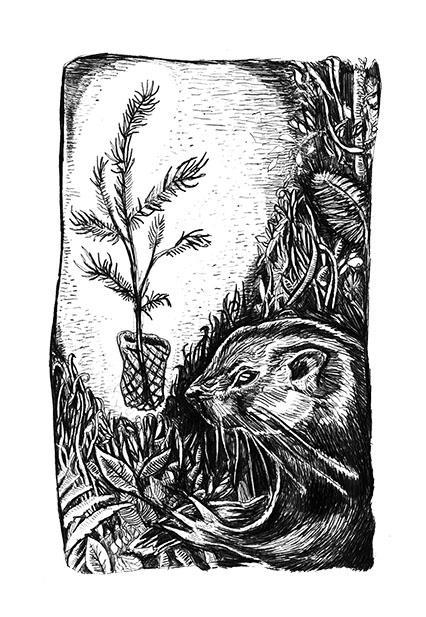by Wiley Cypress / Earth First! Journal

Aplodontia rufa aka the Mountain Beaver. Artwork by Kat Eng.
Mountain beavers (Latin: Aplodontia rufa; also known as boomers, ground bear, or sewellel) are not actually beavers and they don’t really live on mountain tops. As the only surviving species in their family, Aplodontia rufa is a “living fossil” among rodents. Because of a strange inability to retain water, aplodontia are physiologically restricted to the temperate rainforests of Cascadia. They are solitary rodents who only hang out with each other to mate. They eat their own poop, have slightly opposable thumbs, and host the largest known species of flea.
Though city slickers and out-of-towners might question the existence of such a magical animal, Cascadian foresters and forest defenders alike are all too familiar with the mountain beavers’ many scattered burrows—snares for the unsuspecting ankle. These logger boot-sized burrows are often marked by a curious pile of foliage, as most mountain beavers spread their food out to dry at the mouth of their holes before eating.
Aplodontia: ancient, reserved, humble. Yet every discreet boomer hovel is an underground resistance cell. For every GMO beet crop destroyed in the dead of night, for every log truck tank sugared by a Southern Oregon punk, there are thousands upon thousands of mountain beavers gnawing away at the profits of big timber every day. Mountain beavers cost the Northwest timber industry at least 30 million dollars annually.
In an undisturbed forest, mountain beavers eat ferns and other little green things in the understory, as well as the occasional sapling. In a young tree plantation, however, their normal food source is sprayed with herbicides to remove any other plant that might compete with the monoculture doug fir crop. Rather than starve, the resilient aplodontia will lay waste to a tree farm, thwarting the neat rows of industry. Tree planting, while important to restoration work, is also what keeps the timber industry running despite having already logged ninety-five percent of old growth forests in the Pacific Northwest. Doug fir saplings are future product, and timber landowners can’t afford to lose the majority of their product to a rodent.
State and corporate repression of the boomer has been open and vicious. Forestry departments and private timber holders throughout Cascadia spend millions of dollars every year trapping and poisoning mountain beavers to protect their bottom line. On a public hike last year in the Elliott State Forest, Oregon Department of Forestry representative Norma Klein bragged about their “management” of the local mountain beaver population, which involves hiring prisoners from the Shutter Creek Correctional Institute to set and clean traps in fresh clearcuts.
Norma deflected questions about how many mountain beavers die for industry every year in the Elliott (“A lot. But it’s a very, very small percentage of their total population…”), but conservation groups estimate the number to be 3,000. In an ancient forest, aplodontia are a “keystone species”—an animal that plays a critical role in maintaining its ecosystem—because their prolific burrow systems are used by so many other animals. But in a fresh clearcut they are considered vermin.
Mountain beavers are not an endangered species, so they are generally left out of the media messaging of conservation organizations. The mountain beaver is not as rare or charismatic as the Northern Spotted Owl, and it will never provide solid grounds for an environmental lawsuit. Yet the fact that extreme logging practices in the Pacific Northwest have driven public agencies to exterminate a native, keystone species—and the fact that they rely on the prison industrial complex to do so—demonstrates the essentially corrupt, unethical and desperate nature of the timber industry.
So, here’s to Aplodontia rufa. May they live forever; may they always shelter other forest critters and terrorize tree plantations, until tree plantations are wilderness again. May they ever gnaw on the bones of industrial civilization.
————————————————————————————————————————————
 Summer Subscription and Donation Drive!!!
Summer Subscription and Donation Drive!!!

This article is featured in the latest edition of the Earth First! Journal printed magazine. To order a copy of this issue, titled our Spring/Beltane 2014 edition, visit the Back Issues section of our Merchandise Store.
Don’t miss out on the next issue of the EF!J—click here to subscribe to the Earth First! Journal! Support the only biocenric magazine in print that keeps you connected to the worldwide movement of eco-defense! Celebrating 34 years in print and counting! Keep it Wild y’all!
Subscribe by August 15th to receive the Summer/Lughnasadh 2014 edition in your mailbox!

